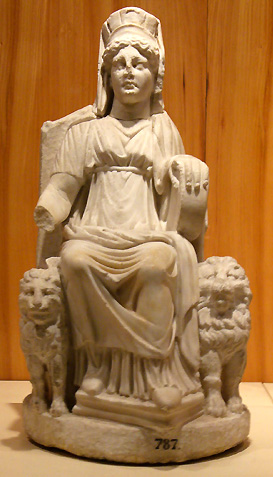Statue of the goddess Cybele, sitting on a throne, from Nicaea in Bithynia
(modern Turkey), dating to the II-I century B.C., now in the Archaeological
Museums (Arkeoloji Müzeleri), Istanbul, Turkey.
Divinity of Oriental origin, probably Anatolian, Cybele was introduced
in the Greek world in the VII-VI centuries B.C., as a goddess of fertility
and of the vital force. In Asia Minor she was worshiped with the title
of “Mother” or “Great Mother”, and was acclaimed
by the Greeks as “Mother of the gods” (Homeric Hymns,
XIV). She was identified sometimes by the Greeks with Rhea, Cronus’s
wife and mother of Zeus and of the other Olympic gods. The goddess is
frequently represented flanked by two lions or panthers, an iconographic
pattern which derives from the Anatolian female divinities of the Neolithic.
Furthermore, it was believed that Cybele could protect against the diseases,
and, as a mother goddess, was called upon for helping both the mothers
and their children. In her honour were celebrated ceremonies consisting
in unbridled processions, of a Dionysian style, with music and dances,
led by the Korybantes, the Phrygian priests of the goddess, who performed
“wild” and captivating dances to the sound of tambourines
and cymbals (Roller 2005).
[Source: http://commons.wikimedia.org/wiki/File:Cybele_Bithynia_Nicaea.jpg]


